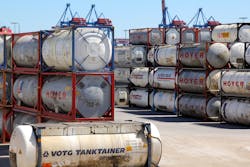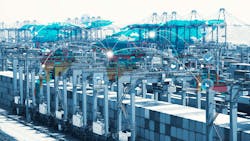Multimodal fleets rely on a network of vehicles and transportation modes (such as trucks, trains, ships, and planes) that transport goods using multiple modes of transportation during a single journey. The term “multimodal” means using different forms of transportation to move cargo from its origin to its destination. A company with a multimodal fleet might have trucks for over-the-road transportation, ships for maritime transport, and airplanes for air cargo.
For success, the multiple modes of transportation must be integrated seamlessly to optimize efficiency, reduce costs, and enhance the overall logistics process.
Multimodal transportation involves using specialized containers and equipment that can be easily transferred between different modes of transport without the need to unload and reload the cargo. For example, goods can be transported in standardized shipping containers, loaded onto trucks, then transferred to trains, ships, or planes, and finally delivered to their destination by another truck. These standardized containers can be easily transferred between different modes of transportation, reducing the need for manual handling, and speeding up the logistics process.
Multimodal fleets enable the transportation of goods across long distances and international borders. They are crucial in facilitating international trade and connecting different parts of the world. Multimodal transportation is often more cost-effective and environmentally friendly than using a single mode of transport for the entire journey. It allows for the optimization of routes, increased asset utilization, and reduced fuel consumption.
Global visibility is essential for bulk shippers using multimodal fleets. Advanced tracking technologies and communication systems allow for real-time monitoring of shipments and enable stakeholders to track the location and status of cargo throughout its journey. Achieving global visibility for multimodal fleets requires a combination of advanced technologies that enable real-time tracking, data sharing, communication, and analytics across different transportation modes and geographic locations.
Supply chain visibility technology and related data integration allow companies to react quickly to disruptions and interruptions in supply chains. End-to-end supply chain visibility provides companies with real-time data and a holistic understanding of their partners across the end-to-end supply chain, starting upstream at procuring materials or semifinished goods and ending downstream when products reach the end customer.
Visibility goes beyond knowing where stuff is at any point in the supply chain. More and more organizations recognize that combining visibility and data is critical to future planning, relationship management, and crisis response. Visibility improves resiliency in a business and supports de-risking. Knowing the real-time location, production rates, and delivery schedules (among other variables) of raw materials and components across the global supply chain makes identifying and mitigating disruptions easier.
Bulk shippers can identify bottlenecks and optimize routes by having a comprehensive view of the entire journey, reducing transit times, improving customer satisfaction, and lowering transportation costs. As today’s customers expect timely and accurate information about their shipments, with visibility, shippers can provide customers with accurate estimated arrival times and updates.
With visibility comes actionable data that helps supply chain executives make more informed decisions, such as where to reposition or preposition inventory because of an issue with a transportation mode, such as a potential rail strike. For example, to help companies’ production facilities remain operational as long as possible, empty railcar pipelines can be increased to various facilities so plants can continue operating and producing products.
Visibility helps bulk shippers identify potential risks such as delays, route diversions, or security threats. By being aware of these risks in real time, appropriate actions can be taken to mitigate them and ensure the safety of goods in transit.
Technologies for global visibility
Organizations must integrate multiple technologies and systems to achieve comprehensive global supply chain visibility, tailor them to their specific needs, and ensure interoperability among supply chain partners. The internet of things (IoT) has become a gamechanger in supply chain visibility. It provides real-time data and insights that enable businesses to optimize their operations and enhance overall efficiency.
These technologies include telematics devices and GPS tracking equipment that tracks vehicles’ and containers’ location, speed, and movement. GPS trackers provide real-time location data, which is crucial for monitoring the progress of shipments. IoT sensors on cargo, containers, and vehicles can collect data on temperature, humidity, shock, and other environmental conditions, ensuring the safety of goods during transit. RFID technologies enable efficient container and cargo tracking to facilitate accurate inventory management as well.
With all these tracking devices, large amounts of data are collected to provide insights into operational performance, trends, and areas for optimization. Big data analytics can help executives make more informed decisions and improve efficiency. Artificial intelligence (AI) and machine learning (ML) tools analyze historical data and real-time information to predict shipment delays, optimize routes, and provide intelligent insights for better decision-making.
Why a GSCV platform is best
A global supply chain visibility (GSCV) platform seamlessly integrating various data sources along the supply chain is critical for enhancing bulk multimodal shipments’ visibility. Data is collected via electronic data interchange (EDI), APIs, tracking devices, and manual input. The platform must aggregate and centralize the collected data to create a single source of truth for supply chain information. The collected data needs to be enriched with other information, such as tracking events, estimated arrival time (ETA), geolocation data, and weather conditions. A dashboard displays the location of goods in a map view or table, the goods’ current status, and relevant events of exceptions, such as a shipment being delayed. When an event occurs, the platform alerts appropriate people and informs them of what is happening along the journey.
A GSCV platform may use predictive analytics to forecast potential disruptions or delays based on historical data and current conditions, helping companies to be more proactive in mitigating risks. Predictive analytics models use historical data and real-time information to forecast demand, anticipate supply chain bottlenecks, and mitigate risks proactively.
Companies gain transparency in their supply chains with a GSCV platform that centralizes information all in one system. This single platform combines truck, rail, barge, and ocean freight, allowing shippers to plan, book, execute, and track shipments in one place, providing visibility for the entire shipment lifecycle. While some vendors only provide a tracking platform, most bulk shippers find their business requires a more robust solution that helps them book and execute shipments as well.
A supply chain visibility solution with booking and execution capabilities streamlines the shipping process. By automating booking and execution processes and optimizing supply chain operations, shippers reduce costs associated with manual data entry, errors, and inefficiencies. Based on historical data and performance insights, they can negotiate better rates with carriers.
Bulk shippers can track shipments from order creation to final delivery, regardless of the parties and systems involved. They can proactively address problems, such as rerouting shipments or adjusting delivery schedules, minimizing the impact of delays or unforeseen events.
For example, ocean freight carriers need help with lost containers, congested ports, shipping containers and chassis shortages, rising freight rates, and crew shortages. Shippers and logistics providers will know where each asset is located in real-time by tracking and sensing containers and chassis through the supply chain. With real-time data on container arrivals, companies can better manage their inventory levels and optimize stock replenishment. This prevents overstocking or stockouts and minimizes holding costs.
Visibility solutions for bulk shippers enable data-driven decision-making and help shippers navigate the complexities of modern supply chains while ensuring that goods are delivered reliably and on time. Global supply chain visibility solutions enhance efficiency, reduce costs, improve customer service, and help to build a competitive advantage.
Bernard Cohen is the group product manager at IntelliTrans, a Roper Technologies business that provides unified and proactive solutions to manage complex supply chain needs.
About the Author
Bernard Cohen
Group product manager
Bernard Cohen is the group product manager at IntelliTrans, a Roper Technologies business that provides unified and proactive solutions to manage complex supply chain needs. Cohen is a supply chain SaaS executive with more than 15 years of experience focused on the creation of product strategies and pipeline development.

